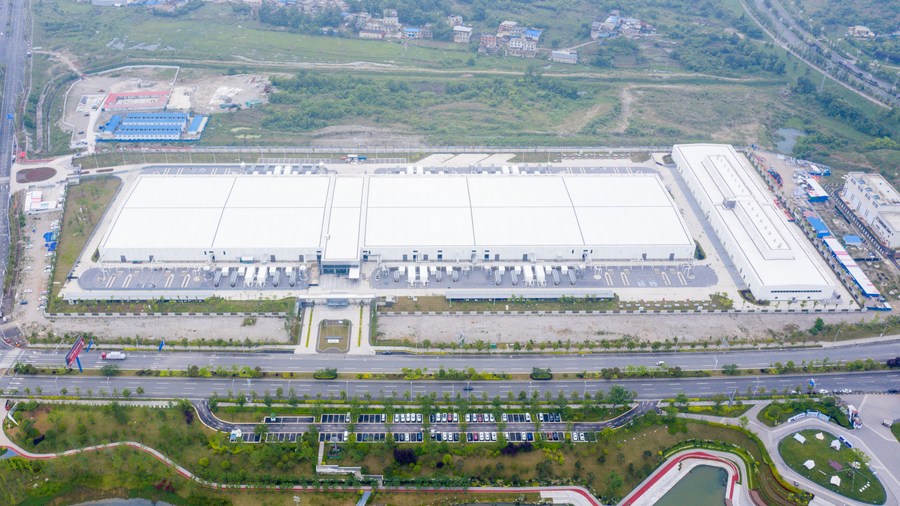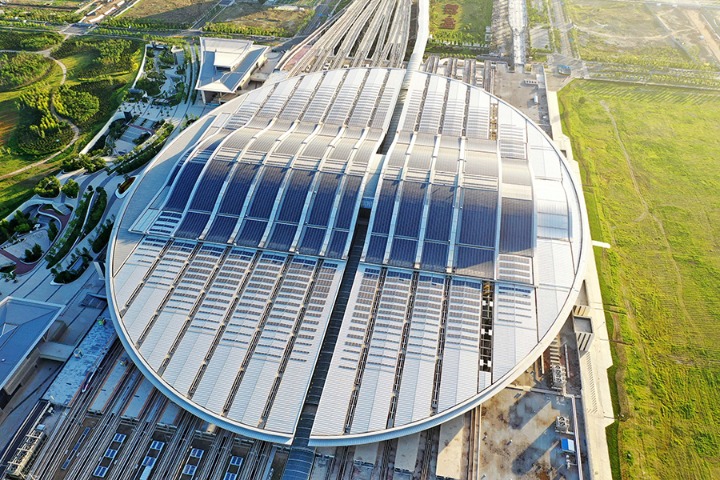* More than 40,000 years ago, ancient Chinese ancestors made fires and took shelter in dark caves; in today's digital era, such caves are turned into safe and secure data storage centers in Guizhou.
* As the country's first national big data comprehensive pilot zone, the province is now labeled "digital Guizhou."
* Last year, Guizhou became a key node for China's grand project of channeling more computing resources from eastern regions to its less developed yet resource-rich western regions.
by Xinhua writers Yao Yulin, Wu Si, Xiang Dingjie
GUIYANG, June 3 (Xinhua) -- More than 40,000 years ago, ancient Chinese ancestors made fires and took shelter in dark caves; in today's digital era, such caves are turned into safe and secure data storage centers in the city of Guiyang, also known as China's Big Data Valley, in the country's southwestern mountainous Guizhou Province.
As the country's first national big data comprehensive pilot zone, Guizhou now boasts 37 data centers in operation or under construction, working for enterprises including Apple, Huawei, and Tencent, as well as scientific research projects like the Five-hundred-meter Aperture Spherical Radio Telescope (FAST), or the "China Sky Eye."

This aerial photo taken on May 24, 2022 shows a data center of Apple in Gui'an New Area, southwest China's Guizhou Province. (Xinhua/Ou Dongqu)
The province has promoted the big data industry as its backbone, with 37 percent of its GDP coming from the digital economy in 2022. Its digital economy is taking the lead nationwide, maintaining the country's highest growth rate for seven consecutive years.
Last year, Guizhou, endowed with numerous caves created by its signature vast karst landscapes, became a key node for China's grand project of channeling more computing resources from eastern regions to its less developed yet resource-rich western regions.
MYSTERIOUS HUMAN DWELLINGS
With most of its parts tucked away in deep mountains, Guizhou has remarkable karst landforms, with vast unknown underground cave resources. For hundreds of millions of years, it has been experiencing intermittent geological uplifts, creating more than 5,000 limestone caves.
Some karst caves sheltered primitive humans from storms and beasts and gradually became their primitive homes. At the Zhaoguodong cave site, Gui'an New Area of Guizhou, researchers found rich cultural layers dating back around 44,000 to about 3,000 years in soil and rocks of merely eight meters in thickness.
So far, 51 ruins using fire and two tombs have emerged there. About 25 kinds of recognizable animal remains, including pig, cow and tiger, and plants like rice, millet, kiwi fruits and grapes, were discovered.
"The ruins at Zhaoguodong cave site span the entire late Paleolithic and Neolithic Age, very rare in the whole country," said Zhang Xinglong, deputy director of the provincial institute of cultural relics and archaeology, adding that the site boasts one of China's hitherto most abundant fire remains in the late Paleolithic Age.
Modern Guizhou still treasures its historical and cultural bonds with the caves.
In Longchang Township of Xiuwen County, Wang Yangming, one of the most influential Neo-Confucian philosophers in the Ming Dynasty (1368-1644), used to live in a natural cave after being relegated by the emperor. The Yangming Cave, where he lived, is now deemed a shrine for his followers and the birthplace of his ideas, drawing tourists, scholars and experts.

A concert is held in a karst cave in Suiyang County, southwest China's Guizhou Province, May 4, 2023. (Xinhua)
During this year's May Day holiday, Shuanghe Cave, Asia's longest cave in Suiyang County of Zunyi City, held a trendy week-long music festival, the first of its kind in the province's karst caves.
The novel karst cave music week helped attract about 38,000 visitors and music fanatics to the cave during the holiday.
While the symphony of natural echoes and beautiful notes helps refresh people's experience of the old caves, Guizhou is also tapping into the cave resources to develop its digital economy centered on big data.
DATA TREASURY IN MODERN DAYS
In Gui'an New Area, the Chinese tech giant Tencent built a data center based on the shape of mountain caves. The Gui'an Qixing data center covers about 470,000 square meters, with over 30,000 square meters inside tunnel caves. Seen from a distance, the data center lies covered in green vegetation, no different from natural mountain caves.
As China's first cavern data center, it can accommodate 300,000 servers, of which one-sixth are inside its five tunnel caves to store the company's most crucial big data.

This aerial photo taken on May 24, 2022 shows the "Huawei Cloud" data center (R) and the Tencent Qixing data center (L) in Gui'an New Area, southwest China's Guizhou Province. (Xinhua/Ou Dongqu)
Tencent constructed the cave data center while restoring its surrounding vegetation to protect the local environment and make the center blend in. The design, inspired by mountain caves, can make good use of external cold sources and ward off the possible influence of outside air on the facilities inside, according to the company.
According to the on-site inspection conducted by the Ministry of Industry and Information Technology, the center's maximum power usage effectiveness (PUE) was logged at around 1.1 -- the closer the value is to 1, the better the energy efficiency. Whereas for most newly built data centers in China, the average PUE is 1.73.
"It was the first time for Chinese designers to break through the conventional design concept of setting up data centers on the ground and to build data centers inside the caves," said Zhong Shan, a senior engineer from Guizhou Transportation Planning Survey & Design Academe Co., Ltd., who had participated in the Qixing data center construction.
Located in the hinterland of China's southwestern inland, Guizhou has a favorable cool climate all year round, providing natural "air-conditioned rooms" for busy heat-emitting servers. Fortunately, the province is away from major earthquake zones, making it safe for data "reservoirs." Moreover, Guizhou's determination to pioneer its big data industry has gathered a cluster of enterprises in the industry, said Zhong Yuanhe with Tencent's global data centers.
Setting up such data centers in Guizhou can save about 58 percent of electricity bills compared with building the same centers in coastal areas in southeast China. If calculated by 10,000 units of standard server racks, a data center can cut 130 million yuan (about 18.57 million U.S. dollars) of electricity bills annually, said Jiao Delu, chief engineer of the provincial big-data development administration.

A staff member works at the State Key Laboratory of Public Big Data at Guizhou University in Guiyang, southwest China's Guizhou Province, May 27, 2022. (Xinhua/Ou Dongqu)
Guizhou now has China's first national big data engineering lab and first big data bourse, with the country's leading combined computing power. As one of the regions with the world's most ultra-large data centers, the province is now labeled "digital Guizhou."
The province also vows to see the overall output value of its electronic and information sector empowered by big data exceed 350 billion yuan by 2025. And by that time, its digital economy is expected to account for about one-half of its GDP.
Luo Dan, a researcher at the China Academy of Information and Communications Technology, said that data centers deal with the reception, processing, storage, and transmission of data streams, and such data centers have become one of the most significant information infrastructures in today's digital economy.
"Building the centers, a conventional energy consumption behemoth, inside the caves can reduce energy usage and is massively significant to our eco-friendly data center construction in achieving a digital China and our carbon neutrality goal as scheduled," Luo said.
(Video reporters: Liu Qinbin, Xie Wentao, Wu Si, Ou Dongqu; video editors: Liang Wanshan, Li Qin) ■












